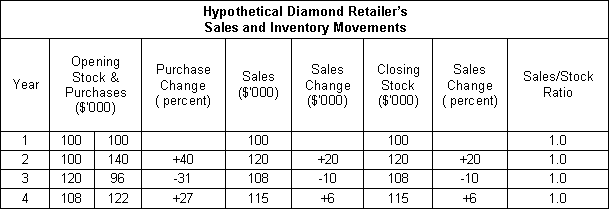IDEX Online Special: Embrace for the Diamond Trade’s Ripple Effect
October 15, 08
The now inevit
One might remember 2001, a difficult year for diamond industry, which began against the background of a weakening global economy and an excess inventory of polished diamonds held mainly by the US trade. This is quite compar
In 2001, the economic uncertainty was aggravated by the terrorist attack in September; in 2008 we faced the liquidity crunch and banking defaults beginning in September. However, in 2001 Christmas season retail sales of diamond were still
If a consumption decline of only 5 percent will be the end result of 2008, I think we should consider ourselves lucky. We better embrace ourselves for more. The liquidity crunch and economic uncertainties are greater (and globally wider) now than they were in 2001. What we saw in 2001, and what we will see in 2008 and 2009, was that de-stocking by the retail trade and lower demand for diamond had a negative impact on the rough diamond market in the form of downward pressures on rough demand, downward pressure on prices, shortage of liquidity and reduced profit
How the Ripple Works
The ripple works both ways – both in a growing and in a falling market. It is premised on the facts that under certain circumstances, increases of diamond retail sales of a few percentage points, let’s say 5 percent, may well trigger a correspondent rise of industry rough diamond off-take of some 15-20 percent. The reverse may also be true, as we have seen in 2001: a small decline in retail sales, in conjunction with negative trade sentiments, may cause a substantial fall in demand for rough and cutting centre polished diamond sales. This occurrence is known as the ‘ripple effect’ and the ‘reverse ripple effect’.
How does this phenomenon manifest itself? If it takes an average of 22-26 months for a diamond to move from ex-DTC level to the consumer, this means that the total normal pip
If consumer purchases decline, as we expect will happen in 2008, the need for the retailer to replenish stocks falls accordingly. Depending upon trade sentiment, he will also be satisfied with a lower level of stock. Thus, a small reduction in retail sales will trigger a far greater decline in the level of replenishment. These dynamics will be repeated at every intermediate level of the diamond pip
This is the ripple effect. Take a hypothetical example (see following table): A retailer whose stock turns around once a year has an opening stock of diamonds of $100,000. His sales also totaled $100,000. In the next year, he sells $120,000, i.e. a 20 percent increase on the preceding year. Being optimistic about the future, he wants to have a stock of $120,000 at the year-end. Consequently, his diamond purchases went up that year by 40 percent, from $100,000 to $140,000.
Now let’s look at a different scenario in which the market falls. In the third year, the retailer’s sales declined by 10 percent to $108,000. Because of his now pessimistic view of the economy, he feels that his stock level should be adjusted in line with his sales volume. In such a year, the retailer’s diamond purchases from his wholesale supplier would plummet by a figure much greater than 10 percent (in this hypothetical view by 31 percent).
What happens in the retail sector also occurs in diluted form at each stage of the pip

Diamond dealers in the cutting centers almost “intuitively” live the Ripple Effect. The World Federation of Diamond Bourses has already appealed to the producers to reduce sales to the market and De Beers has already announced it will decrease output next year (and concentrate on mine maintenance projects at the expense of maximizing production). As the rough market is more demand-driven today than it was in 2001, or, to be more precisely, as the “rough placing power” of the producers has lessened, diamond manufacturers feel less compelled to buy goods they don’t need than in the past.
One of the problems the industry is facing this time around is the suddenness and severity of the economic crisis, introducing exacerbating factors. The credit crunch stymies businesses on each level of the pip
A bad season will dampen the retailer’s confidence. Combined with the credit crunch, and given the negative sentiments, he will replenish at significantly lower levels early next year. That’s the Ripple Effect at work. At this still early stage, we can only quote the stewardess who demanded that we fasten our seat belts and sit tight. We are in for a very bumpy ride.